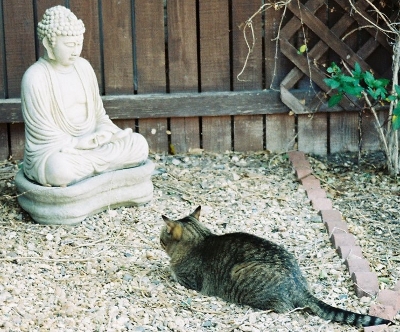Paulo Coelho wrote a nice piece about how cats came to be regarded as necessary for meditation for a few generations in Japan. The story might resonate with just about anyone in just about any context.
In my case, it reminded me of longstanding assumptions about how things “must” be done in the IT field. The following quote sums up the state of corporate IT in a nutshell: “..society continues to create some systems which, in the fullness of time, lose their reason for existence, but continue to impose their rules.”
This is how the assumptions, standards, and all the certifiable things in our field originated:

A cat
once sat
right at
the master’s side during meditation
a copy-cat
got a cat
hoping that
it knew the path to wisdom
people sat
other cats
on the mats
in the monasteries of the nation
pilgrims wandered
scholars pondered
and in academic papers laundered
a cuddly theoretical formulation
now supported by science
a feline appliance
became a fundamental reliance
for navel contemplation
then one seeker
thinking deeper
questioned how the furry sleeper
aided in their meditation
masters shrugged
scholars rubbed
their bearded chins and scrubbed
the cats from the equation
schools of thought divided
and mutually derided
until it was decided
the whole cat thing had been a bit silly like you know the gag about the sandals in Life of Brian so let’s just get on with our meditation and not talk about it anymore especially about exactly who used to believe cats were a necessary part of it because there’s no sense embarrassing anyone after all and we know better now
(Aside: Yeah, I could reduce that to four or five syllables if I really wanted to. Believe it.)
in the twentieth century
a new religion called eye tea
founded many monasteries
for the art of software-making
cats they herded in large numbers
each one claiming special thunder
cats, they claimed, avoided blunders
in the art of software-making
soon enough the academics
with skilful calisthenics
codified feline polemics
for the art of software-making
software needs much help to grow
special departments, special roles
line them up all in a row
for the art of software-making
to assure standardization
not to mention remuneration
some defined certifications
in the art of software-making
prince they crowned, and then prince two
maturity models just for you
pee ‘im eye and scrum-de-doo
for the art of software-making
magic bullets don’t exist
except for ours, they all insist
ours is the cat that will persist
in the art of software-making
everybody toe the line
and the software comes out fine
you don’t need a brain or mind
for the art of software-making
then a few practitioners
questioned the particulars
of the kitty regulators
in the art of software-making
…and that brings us up to the present. Guess what happens next or be condemned to repeat history. (Hint: We’ve reached “schools of thought divided and mutually derided.”)
You probably don’t need to be told the cats in the monasteries of IT are the deeply-held assumptions about how IT work “must” be done: There “must” be a separate IT department. There “must” be certain specialized professional roles. There “must” be a certain sequence of steps in developing software. There “must” always be a certain number of defects. Any schedule pressure “must” result in design debt. There “must” be a way to make software development into a repeatable assembly-line process. We “must” deliver applications via discrete projects. There “must” be a Single Best Way to do everything everywhere always.
It would be inconceivable to deliver software without these cats.
And you already understand that eye tea can only be tears: The most common result IT departments produce for their customers.
If we all worked on the assumption that what is accepted as true were really true, there would be little hope of advance.
Orville Wright
‘Scuse me while I cough up a hairball.